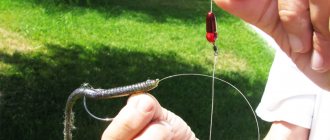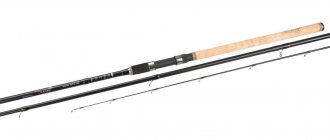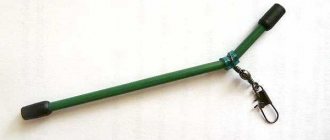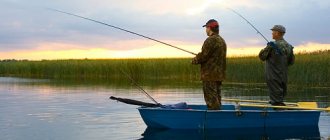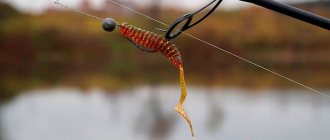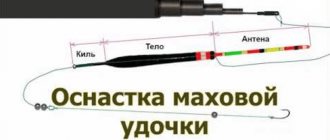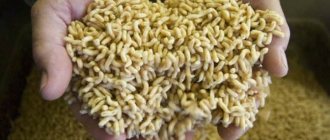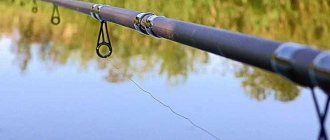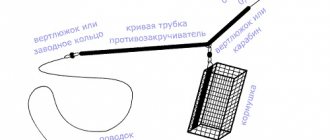For some fishermen, especially beginners, equipping a float rod for crucian carp will seem like a simple matter. What is there - I secured the float, selected the required pellet, and tied the hook. However, nuances arise later - light float or heavy, the diameter of the leashes, the size of the hooks. On the one hand, it bites better on the lungs. On the other hand, in the current and wind, light equipment is blown away. Let's take a closer look at how to properly equip a float rod for crucian carp, depending on the fishing conditions and the personal preferences of the fisherman.
Fishing for crucian carp with a float
The tactical features of fishing for silver (and gold) are discussed in detail in a separate article about catching crucian carp with a float. Here we will dwell on how to correctly assemble a fishing rod for crucian carp with a float, with or without a reel, blind or sliding equipment, light or heavier. That is, we will directly analyze the nuances of equipment, proper loading and types of installations.
Simple and long casting
If you do not take into account match equipment, basically all amateurs use a fly tackle, a fishing rod with a small inertial reel, or a popular version of the Bolognese fishing rod, a Chinese telescope with the same inertia-free reel. A swing or fishing rod with a simple reel is for short casting. Moreover, in the first case, there is no supply of fishing line in the equipment - which is bad when fishing for large fish. But the fly rod is light and comfortable. For catching even large crucian carp on a float, this tackle is perfect - if you don’t need to cast far and there is no chance of the carp biting.
- If you make a fishing rod for crucian carp with a spinning reel, in addition to the near zone, it becomes possible to make long casts. And here, the better the reel and rings, the thinner the line and the heavier the equipment, the further you can cast.
- Even the cheapest Chinese reel on a regular 4-5 meter fishing rod with a 0.14-0.18 mm fishing line perfectly casts a rig from a 2 gram float at a distance of 10-20 meters. True, to do this you have to sand the seam on the reel spool with zero-grade sandpaper so that it does not slow down the line, and have good experience in casting light rigs from behind the back in a swoop. Usually on small rivers and ponds this is enough.
- If you need a longer cast, then we use larger floats with a load of 4, 5 or more grams, or even match rig options. Match tackle is not necessarily any special sports tackle. You can make an analogue of it for amateur fishing on the basis of an ordinary telescopic fishing rod with a spinning rod.
- The equipment of a fly rod for catching crucian carp, as well as with a simple reel, and the Bolognese version with a spinning rod are the same, right down to the options for pure match equipment. More precisely, the principle of its correct construction is the same.
Fishing rod equipment for catching crucian carp with a float
In 99% of cases, when using a float rod for crucian carp, you need tackle for fishing from the bottom. When the crucian carp bites boldly and there is a hunger, coarse thick rigs also work. However, in spring and autumn in clear cold water, as well as in summer, when it has already eaten, this fish is often capricious. And he can simply not take the bait, spit it out if, when rising from the bottom, he feels a heavy weight or resistance from the equipment.
The main requirement for equipping a fishing rod for crucian carp is maximum sensitivity. This is a fairly large fish - it easily moves and pulls a weight of 5, 10 grams or more. When it bites well. However, when testing the bait, sensing something is wrong, the crucian carp often stops trying to swallow the bait. Therefore, it is always better to use thin, neat rigs. Since the rude ones only work when they are hungry. The diagrams proposed below for correctly equipping a float rod for crucian carp have been tested over years of practice. And they are simple amateur equipment options, without unnecessary sports bells and whistles and expensive elements.
Blind equipment
Sometimes anglers argue which float equipment for crucian carp is better, blind or sliding. However, I think there is no difference - as long as the float is properly loaded. Mounting a fishing rod on a crucian carp can be done in any way. For long-distance casting, the sliding version is more convenient. Rigging a fly rod for crucian carp is rather a blind option. You can rig a Bolognese fishing rod for crucian carp this way or that way. The depth still rarely exceeds the length of the rod. Blind equipment is simpler, neater and more reliable. No stoppers needed. However, for long-distance fishing with depths of 3 meters or more, the sliding option is more convenient, since the float goes down to the sinker.
For example, I almost always fish with solid light floats with a spinning reel - even when the depth is under 5 meters. Yes, when casting a rig, when the float is right at the tip, inconvenience arises. But they can be solved by careful and precise casting, training and practice of casting the tackle. So it's more a matter of personal preference. Effective rigging for crucian carp can be done in both cases - this is more about loading the floats, choosing the diameter of the fishing line and hooks. It doesn’t matter how the float hangs, tightly or slides, as long as it’s done correctly.
Usually the float in the blind version is attached to the leg through a pair of cambrics. If there is a ring in the body, we pass it through it too. Also - a feather float, we plant it on 2-3 cambrics of the required diameter. Microfloats with a short keel and antenna can also be attached to one point. It is important here that the float sits firmly on the fishing line, but moves under force to adjust the depth. This is achieved by selecting the diameter of the cambrics and their density depending on the material.
Small floats up to 3 grams are often deaf, while large floats are sliding. However, there are fans of small sliding floats, as well as large deaf ones.
Sliding float
In the sliding version, you can make a float tackle for crucian carp with your own hands from an ordinary blind float. To do this, you need to attach a metal or plastic loop to the leg. Ready-made connectors are also sold. The type of sliding float - with one point or two - depends on the number of such loops. The second ring is usually located in the float body itself.
The line passes through the rings, and the level of the float is adjusted with stoppers. The upper one is for setting the depth, the lower one is so that the float does not fall directly on the load and does not get confused with the leash.
- Rubber stops do not fit into the rod rings. Therefore, in the rigging of crucian carp fishing rods for long-distance casting, which are created for fishing at depths significantly exceeding the length of the rod, you need to use micro-stoppers, special knots that taper in the direction of departure with a cone - so that they pass the rings well when casting.
- In such equipment, the holes on the float itself also need to be small so that the microstop does not slip through. But this is already a rare case. At such depths it is easier to fish with a feeder or donka, so as not to have to worry about knitted stoppers.
- A sliding float with rubber stoppers is a universal tackle. But what is more important here is the correct loading itself, and not the method of attaching the float. A rod for catching crucian carp from the shore is usually 5-6 meters. This is enough for the near zone. But they can also be used for long-distance fishing. A properly equipped fishing rod for crucian carp is not a special tackle for this particular fish. Depending on the leashes and the size of the hooks, you can catch either carp or roach with it.
Detailed article - sliding float for crucian carp
What kind of float is this
First, it’s worth understanding the term. In the standard version, the float mechanism is tightly attached to the equipment, at a certain distance from the sinker. This obliges the fisherman to look for a place that will be suitable specifically for such installation. The sliding version of the alarm requires fastening in such a way that it becomes possible for it to move freely along the fishing line between points pre-designated by the fisherman.
Did you know? In ancient China, fish were caught using cormorants. In order to later take the prey from the bird, special rings were put on its throat, which prevented swallowing.
Where is it used
This type of float installation allows you to make long casts in any weather conditions . This is very beneficial when catching fish that rarely swim to the shore (carp, carp, silver carp) and staying at a distance near the bottom. If there is no boat nearby, then cautious specimens approach the bait much more readily.
At the time of casting, the center of gravity is at one point, since the float is located not far from the sinker. This allows you to perform manipulation without interference (winding the fishing line around the rod). After hitting the water, the sinker sinks to the bottom, and the float rises to the second stopping point and is ready to send bite signals.
Also, using such a device, it is possible to fish at great depths. For example, when the length of the rod is 5 m, and the distance to the bottom is 10 meters or more, it is simply impossible to cast at such a distance with a blind fastening of the float. And if the alarm device slides along the fishing line, then when the stopper is installed in the desired area and there is a sufficient supply of thread, it becomes possible to catch at any depth.
Another area of application for a sliding float is catching predatory fish with live bait. This arrangement of the signaling device and the movable sinker allows the fishing line to easily pass through them.
Thanks to this, when catching the bait, the fish does not feel resistance, and therefore is firmly fixed on the hook.
In addition to the above, it is advisable to use a sliding float in currents or in strong winds.
A tightly fixed buoy is severely blown away or covered by a wave, while a mobile one stands almost level. For such purposes, a special model of sliding alarms from Hungarian manufacturers is designed.
Operating principle of a sliding float
Catching crucian carp and any other fish will be more effective if the hunter understands the operating principles of the device. The point is that the float moves freely along the line or along it. For this purpose, the alarm has 1–2 holes depending on the model.
The first stopper is located not far from the sinker, and the second is located where it is convenient for the user. They are fixed tightly and have parameters exceeding the diameter of the holes on the float. When casting, the signaling device is located next to the lower stopper, and after immersion in the water it rises to the second stopper, i.e. to the specified fishing depth.
Float for crucian carp
The weight of the float for crucian carp is usually up to 5 grams. 1-2 gram floats are considered light. 1 gram is too little, after all, we’re not catching a hive. The mass of the float for crucian carp is 2-3 grams, or rather, this carrying capacity is just right, the equipment is both sensitive and flies normally on long casts. What is more important here is not the size of the float itself - but the fact that the pellets in the load do not exceed 2-3 grams. The crucian carp does not feel them in this case when it lifts the rig from the bottom. Heavy floats fly well, however, they work poorly for crucian carp in a weak bite if they are loaded incorrectly (more on this later). So, float size is a matter of personal preference. You can use both large and light ones. However, on large floats it is necessary to use sensitively spaced weights, and not place one heavy weight, otherwise such tackle will only work during a good, bold bite, for example, during the spring run.
I myself always use 2-3 gram floats or a goose feather. And in a strong current, where there is no way to stand, I simply fish with a wire, a tightness at an angle to the shore, by floating, or even with a feeder. With such huge floats, which I sometimes notice among fishermen on the shore, I often catch a predator with live bait, rather than peaceful fish. And I have this type of fishing rod rig - not only for crucian carp, it is the same all year - whether for roach, carp or bream. I change leashes and hooks (for carp, of course, without a leash, the hook is on the main line).
How to choose floats for catching crucian carp
Types of gear for crucian carp
There are many types of fishing gear suitable for catching crucian carp. Having studied each individually in detail, you can determine the most catchy one.
Learn how to stew crucian carp in a frying pan and in a slow cooker.
Types of gear:
- float;
- feeder;
- "crucian carp killer";
- crown;
- pacifier;
- spring;
- hair equipment;
- picker equipment;
- drop-shot (regular and nano);
- fishing rod with a side nod;
- spinning.
All types of fishing gear have their own characteristics and are suitable for different fishing methods.
Video: how to assemble tackle for crucian carp
Float
Among fishermen, float rods are the most popular. Such gear is well suited for both coastal fishing and boat fishing, when fishing occurs among bushes and reeds.
The float rod consists of the following components:
- rod;
- coil;
- fishing line;
- float;
- sinkers;
- hook with nozzle.
When choosing gear for spring crucian fishing, it is important to consider that it should be light and as inconspicuous as possible. So, it is desirable that the cross-section of the fishing line does not exceed 0.14 mm. The preferred diameter is 0.18 mm. It is advisable to use an oblong float, with an elongated top, weighing about 3 g. It is recommended to choose a dark color, since when fishing at shallow depths, bright colors can scare away the fish.
Important! You should not choose a fishing line that is too thin, as it can get caught on the branches of bushes and tear. The minimum thickness should not exceed 0.12 mm.
The hook for spring fishing should be selected small . Considering that at this time of year crucian carp feeds on small insects (bloodworms, maggots), hooks No. 12 and No. 14 will be the best option. The suitable length of leashes for float gear is 7-8 cm. This is explained by the fact that crucian carp prefers to lift the bait from the bottom. Longer leaders will be lifted by the undercurrent.
It is better to use lead sinkers. Their weight should be equal to half the mass of the float. If the load is too heavy, the cautious fish, sensing excessive heaviness when biting, will throw the bait. The optimal rod length is 5–7 m. It is better to choose a spinning reel. The spool should be able to withstand 50–60 m of fishing line. Such gear allows you to catch a large number of fish of different sizes. However, there is a possibility that when casting, the fishing line may get caught on coastal vegetation.
Installation of a float rod:
- Thread the line into the ring of the float.
- Put cambric on the fishing line.
- Insert the cambric into the keel of the float.
- Pass the cambric through the line.
- Attach a carabiner, a sinker and a leash with a hook to the fishing line.
Video: the most ideal float tackle
Feeder
Feeder fishing rods belong to the bottom gear and are considered the most catchy. This device is a fishing rod, the length of which does not exceed 3.3 m. The reel is also small, its size is 2,000. The fishing line is thin, only 0.16 mm. The feeder rod is equipped with a feeder weighing about 40 g .
Important! The gap between the loops should be 5 cm greater than the length of the loop on which the feeder is attached. Otherwise, the leash and the feeder will get mixed up.
The advantage of such gear is the very sensitive tip of the fishing rod, which instantly responds to a bite, as well as a fairly simple installation that can be done right on the shore. The disadvantages include tangling of the leash when casting. The easiest way to assemble feeder equipment is a paternoster.
Step-by-step instruction:
- Make a small loop on the main line.
- Attach a 60 cm long leash to the loop. Attach a hook to the leash.
- Having retreated 15–20 cm, make another loop, 15 cm long.
- Attach the feeder to the loop through a carabiner.
"Crucian Killer"
The “crucian carp killer” is a non-sporting equipment for fishing on a feeder. Consists of fishing line, feeders, hooks and sinkers.
You will be interested to know how to cook crucian carp in the oven with potatoes.
Correctly assemble the equipment as follows:
- Make a loop on the main line.
- Attach feeders every 15–20 cm.
- Attach fishing lines with hooks to the feeders.
- Attach a sinker to the end of the fishing line.
The advantage of this method of fishing is the presence of three feeders at once. The disadvantage is the weight of the gear. A fishing line lined with feeders and sinkers creates resistance when biting, which can lead to self-hooking. In addition, when fishing with a “crucian killer”, there is no sensitive bite.
Makushatnik
Makushatnik is a fishing tackle equipped with cake. It is mainly used for catching carp, but sometimes crucian carp also bite on it. For crucian carp fishing, spinning rods are often used, but experienced fishermen prefer feeders.
Installation of the top can be done as follows:
- Place the top of the feeder in the feeder.
- Attach 3 leashes with hooks to the feeder. The length of the leashes should be short, approximately 15–20 cm.
You can add several attachments to the cake, for example, worms or special granules. You can use sunflower seed cake as flour or buy it at a fishing store. Sometimes makukha is given additional scents, such as anise, dill and strawberry.
Find out how to deliciously cook crucian carp on the grill.
The main advantage of this method of fishing is the successful bite. The crucian carp will definitely be interested in the bait and will swim closer. However, if there are few fish in the pond or the time and place of fishing are chosen incorrectly, the makha will become limp in the water and washed out of the feeder.
Video: catching crucian carp on the makushatnik
Pacifier
The nipple is a feeder equipped with three leashes and hooks with attachments. To assemble this type of gear, all variations of spinning rods are suitable - reels of any size and fishing line, the cross-section of which does not exceed 0.6 mm.
Important! You will have to wait quite a long time for a bite, so baits and baits should last up to 10 hours without spreading.
The nipple installation looks like this:
- Place bait on the bottom of the feeder. You can prepare it yourself by steaming the millet in a water bath and rolling it out. Then add semolina. The consistency should be viscous.
- Attach short, up to 20 cm, leashes with hooks to the walls of the feeder.
- Insert the hooks into the bait.
- Attach a carabiner with fishing line to the feeder.
The hooks can be left free by first putting bait baits on them. The advantage of fishing with a nipple is its effectiveness. In this case, the catch will be successful.
Spring
A spring is a type of nipple; however, unlike the latter, viscous feeding is used on spring-type equipment. Cords 5–7 cm long are tied to the feeder. In this case, the hooks are left free, having previously placed foam balls on them. The size of the balls must match the hooks. You need to attach a carabiner with fishing line to the top of the spring feeder.
We advise you to learn how to properly fry crucian carp so that you don’t feel the bones.
Stepping back 15 cm from the carabiner, attach the sinker to the fishing line. To prevent the load from moving to the base, it can be secured with beads on the sides . Fill the feeder itself with bait. The disadvantage is that this method is not sporty, since hooking is achieved due to the weight of the feeder. The advantages include ease of assembly and use of the design.
Hair rig
This option is a type of bottom gear. In this case, the hair is used as a leash on which the bait is placed. At the same time, the hook and sting remain free, the bait is not put on them. The hook is achieved due to the fact that the fish, swallowing the bait from the hair, also sucks the hook itself, without feeling its weight.
In classical fishing, the fish swallows the bait along with the hook, feels it and spits it out. In this case, this does not happen. The hair rig is suitable for catching lake fish, such as crucian carp, carp and carp.
To assemble the hair rig, you need to prepare the following materials:
- fluorocarbon line;
- hooks No. 12; it is important that the size of the hooks ideally matches the size of the nozzle;
- silicone, empty inside, tubes;
- scissors;
- a special carp needle, which will be required to attach the bait.
Fluorocarbon fishing line is used as a leader. At its very edge you need to make a loop as small as possible. Then cut off a fragment no larger than 5 mm from the silicone tube and string it onto the fishing line, not reaching the knot.
Light float
Light equipment for catching crucian carp with a float rod requires neat, oblong floats with a carrying capacity of 2-3 grams. They are also suitable without an antenna - with a button sticking out of the water. It doesn’t matter whether it’s in a blind or sliding version, it’s not for everyone. I use exactly these to catch any fish with a float, on a five-meter rod with a spinning reel. The choice of float for catching crucian carp based on color and decorative elements is up to the fisherman, as long as he enjoys watching the bite.
Such a load with this tackle, if desired (and skill), can also be cast for a long cast up to 30 meters (if not against the wind). A regular telescopic fishing rod with rings, 4-6 meters, although the cheapest, is suitable for this. And also a plastic spinning reel for 200-500 rubles. You can, of course, use expensive ones if you wish. We do the same thing both on the swing and on a fishing rod with inertia - it makes no difference, it’s just that long-distance casting will become inaccessible.
Setting up a fishing rod for crucian carp with a carrying capacity of 2-3 grams is simple - you just need to pick up a pellet and immerse the float almost to the antenna. In this case, several options for use when fishing appear - in the picture these are 1, 3 and 4. Even better - to make a spaced load of two pellets - then tactically another option appears for placing the equipment on the bottom - number 2. And this is what is often needed on a river with a weak current, so that the equipment is pulled slowly with stops.
The fisherman’s task is already on the spot - to experimentally select which position of the equipment in the water at this particular place now works better. The method of simply throwing into the water and waiting for someone to bite often does not work. Shots weighing 1-2 grams do not strain the crucian carp when it takes the bait, even during periods of passive and cautious biting. We surround the goose feather in the same way - it has exactly the same load-carrying capacity.
Heavy float
To load a float onto a large crucian carp, some anglers use one large pellet or olive. However, the crucian carp feels a load weighing 5-7 grams when it picks up the bait. When the fish are hungry or have a good bite, this option often works. However, in the summer, when the crucian carp is full and picky, as well as due to passive biting, this option may not work. Often the crucian carp immediately stops trying the bait, feeling the pressure of the fishing line on the lip under the influence of a heavy weight.
A justified option for using a heavy load is in a sliding version in the current. Here the fishing rod works almost like a half-bottom. When a crucian carp bites, it not only lifts this olive from the bottom - the line also slips, the load between the weight of the equipment and the resistance of the float is equalized.
Spaced load
With large floats, if you need them to work not only for a good bite, we use spaced loading. A large load on the line is needed to almost bring the load to the desired value. It is located on the fishing line in the water column, and when the crucian carp lifts the bait from the bottom, it does not participate in this in any way. On the contrary, such a weight even takes on some of the resistance of the float when pulling. But a small supplement weighing 1-2 grams is not a hindrance for crucian carp. We install it in front of the leash, near the hook, in order to load the float up to the antenna. The rising bite in this case will be expressed in the rise above the water of the previously recessed part of the antenna or the body of the float.
A similar adjustment can be made by selecting the working part of the float on the body itself, or on a long antenna. If the body of the float in the working position is completely under water, then such equipment better resists gusts of wind. And it also works in passive biting, since the crucian carp simply does not feel a large pellet when rising.
Half-bottom and fishing rod with feeder
Float tackle for crucian carp for the current, with a load exceeding the carrying capacity of the float - this is already a half-bottom. Instead of a load, a feeder is often used. Naturally, the rising bite no longer works here - the float is simply recessed when the fishing line is pulled through the sliding spring. It makes sense to assemble a fishing rod for crucian carp with a feeder during the current, for fishing in the spring - when the crucian carp takes it boldly. Still, this tackle is a bit rough for accurate passive bites.
More details - fishing rod for crucian carp with float and feeder
Groundbait and bait for catching crucian carp in the current
Some experts believe that crucian carp is not a picky fish. In fact, crucian carp is quite capricious and you never know what kind of bait it is going to be caught with. Therefore, it is better to take with you baits of various origins: both plant and animal. The main baits when fishing for crucian carp are:
- Muckworm.
- Bloodworm.
- Maggot.
- Pearl barley.
- Bread.
- Semolina.
- Mastyrka and others.
If a large crucian carp bites, then it is better to use corn, peas, crawling or a whole bunch of dung worms to catch it. The minimum number of attachments is one attachment of animal origin and one attachment of plant origin. This can be a dung worm, which is the most common bait, or pearl barley, which is both the most accessible and the most common. You don’t need to boil the pearl barley, just pour boiling water over it, and by morning it can already be used. It is better to do this operation in a thermos.
Nowadays, without bait, it makes no sense to go fishing at all. The same applies to crucian carp. In addition, other fish like to eat, such as bream, roach, rudd, silver bream, etc. Therefore, there is a chance, especially on the river, to catch large bream. As a rule, crucian carp does not dominate on the river due to the presence of predators such as pike and perch, which love to feast on crucian carp.
If there is a current, especially an active one, bait of a special consistency will be required. Good results can be obtained by using macaque, which slowly dissolves in the water column. In this regard, the most common equipment that is used for fishing in the current is a makushatnik. Its advantage is that you don’t need to invent anything special, just attach a pressed fragment of the crown and a couple of hooks. Moreover, makha is quite often present in various bait recipes. It has an attractive aroma, so it is recommended for use when catching many types of peaceful fish.
Line and leashes
- The thickness of the fishing line for crucian carp for a float rod depends on the size of the fish and fishing conditions. For small crucian carp when the bite is poor, thin diameters of 0.08-0.1 mm can be used. For medium crucian carp – 0.12-0.14 mm. In the south, where crucian carp is large, 0.14 mm is probably the lower limit. If there is a possibility of carp biting, then it is better to take a larger fishing line diameter, up to 0.2 mm.
- In the south, where medium-large crucian carp is the main fisherman's trophy - 0.14-0.18 mm. Some use thicker ones, up to 0.3 mm - but such a rope works in the spring when it’s hot, in muddy water. Also, a thick fishing line is needed for catching large fish in the deep reeds - in order to immediately speed up the landing.
- If the main line is thick, then you can simply put a thin leash and move the pellets above it. The length of the leash for crucian carp is selected experimentally, usually 15-30 cm.
Hooks
There are no correct hooks for catching crucian carp with a float rod, although it is widely believed that it is better to use one with a round shank. As with any other gear, the hook is selected to match the bait that we will fish with. For a bunch of worms, hooks with a long shank are more suitable, for corn - round ones, like mini-carp hooks. For one maggot or bloodworm - small and thin, like a roach. For crucian carp it is better to take thin and sharp hooks - it is unlikely that even a large crucian carp on a fishing rod can break the hook with skillful actions of the fisherman.
It seems that advice to buy expensive hooks from athletes on YouTube is nothing more than marketing and advertising. All my life I have been using ordinary cheap Chinese ones from stores, selecting them according to their appearance, size, visual configuration - and not once has a crucian carp told me that it refuses to bite because the hook is not branded or not catchy.
Float tackle for crucian carp with two hooks
A common question is how to tie 2 hooks to a float rod for crucian carp. Counter question - why? Probably to increase the likelihood of confusion. I have always fished with a fishing rod with one hook, and have never reinvented the wheel.
Still, there may be a positive meaning in the second hook. For example, place a short leash higher so that the nozzle is not at the bottom. However, then most likely it will catch not crucian carp, but perch, roach or bleak circling around the baited spot.
To tie the second hook to a float rod for crucian carp, we use any knots and methods, of which there are plenty on the Internet. The main thing is to make sure that the equipment does not get tangled when casting.
Methods for mounting a float rod on crucian carp
To select the correct gear for crucian carp, decide what kind of equipment will be used. Let's look at three main types of gear installation.
Equipment with a sliding float for crucian carp
A sliding rig for crucian carp is used for long casts. To use it, the fishing rod must have a reel. With its help, you can cast to the required distance.
This equipment is equipped with a sliding float. The stopper on the line is a limiter for the movement of the float. Equipment with a sliding float is loaded using an olive.
Since the floats used are heavy, they need to be sufficiently loaded and olives cope with this task perfectly. To prevent the fish from feeling the weight of the load, it can also be made sliding. The olive is put on the fishing line through the internal hole and has free movement. This move is limited by stoppers. Therefore, the stopper can be moved apart somewhat, leaving some movement for the olive. To prevent the weight from moving the lower stopper, two stoppers can be placed below.
Blind float equipment
To equip a fly fishing rod with a float for crucian carp, blind equipment is used. It is called blind because the line is attached directly to the tip of the rod and the length of the line does not change. This is a very light and mobile tackle: you only need a rod and a small reel with fishing line. In addition, you can prepare several such rigs for one fishing rod and quickly change them during the fishing process. Sensitive blind equipment will leave very pleasant memories of fishing.
The floats used are very light, mainly with two attachment points. As a load, pellets are used, spaced along the entire length from the hook to the float.
To avoid overlap, the weights must be placed in this order: the heaviest one is closer to the float, then the weight of the weights decreases.
Float tackle for crucian carp with two hooks
To effectively use two hooks on a float rig, they need to be tied in such a way that they do not get tangled when casting. The rocker assembly will cope well with this task.
It places the hooks some distance apart, preventing tangling. Using this fastening, you can place the hooks in one plane, or one below the other.
The catchy kherabun float tackle also uses two hooks in fishing. One hook is placed above the other so that the bait dough from the top hook is transferred to the bottom hook. To do this, the hooks are knitted on one leash, which also prevents them from getting tangled. Catching crucian carp using a float rod with a feeder is also effective.
A float tackle for crucian carp with two hooks can be mounted using a triple swivel. Then the tackle will also not get tangled.
Match equipment
The correct equipment for a float rod for crucian carp in the match version is made according to the same principle as that for heavy floats. In a purely match version, they spread it even more, placing several weights from heavy at the top to a small underhang in front of the hook. In its pure form, match is a serious tackle on a special rod, with a good reel; special match floats with a weight are used. And, in principle, it’s not just for crucian carp – but for any fish.
Article about match fishing with a rod: link coming soon
Content:
- 1 How to choose a promising location
- 2 The best time to catch crucian carp on the river
- 3 Tackle for catching crucian carp on the river 3.1 Equipment for a float rod
- 3.2 How to equip bottom tackle (feeder)
Almost all avid fishermen learned to fish by going after crucian carp. Although, it is possible that the first training sessions were spent catching minnows and perch. Naturally, catching crucian carp is more exciting, since you come across quite weighty specimens. As mentioned above, crucian carp can be found in any body of water.
Despite this, catching crucian carp on the river has its own subtleties related to the choice of place for fishing, preparation of bait, choice of bait and gear. Moreover, the subtleties of catching crucian carp in the current do not end there.
Summer nod
Another option for equipping a fishing rod for crucian carp is with a nod, without a float at all. This setup works well when fishing local bushes and windows from boats and bridges, especially in spring and summer. A fishing rod for crucian carp and crucian carp with a nod in the south is a fairly common equipment for vertical fishing in water lilies or from a boat in the thickets with a summer jig.
Article about catching crucian carp with a summer nod
Subscribe to the channel:
YouTube channel RYBAFAN
We are VKontakte
Bait for crucian carp
Groundbait from millet and oatmeal
There are many industrial formulations for feeding crucian carp, and even more homemade recipes. The main thing is that it attracts fish to the fishing point.
When fishing with a float rod, the composition must contain small fractions of ingredients so as not to saturate the crucian carp. Therefore, it is necessary to sift the dry mixture through a fine-mesh sieve. The composition must contain disintegrating agents so that when it falls to the bottom, the ball disintegrates and forms a large food stain.
It is necessary to add to the bait those components that will be used as bait.
For bottom fishing, baits are often also baits.
For fishing with a “nipple” or “spring”, the feeder is filled with a thick and viscous mixture such as dough.
The Sensas and Dunaev baits have the best results.
When fishing with a feeder or picker, the feeder is filled with a crumbly mixture. It is similar to bait for float fishing. You can achieve rapid leaching of feed using leavening agents, for example, coconut flakes or sawdust.
You can adjust the consistency of the bait by changing the humidity or the degree of compaction with your fingers in the feeder.
Crucian carp caught with a jig in the summer
Everything about fishing for crucian carp in spring and summer - a detailed review of fishing for the most popular fish in Russia.
The subtleties of catching crucian carp with a float rod in still water and in the current.
Fishing for crucian carp on a feeder - equipment, bait and the fishing process.
